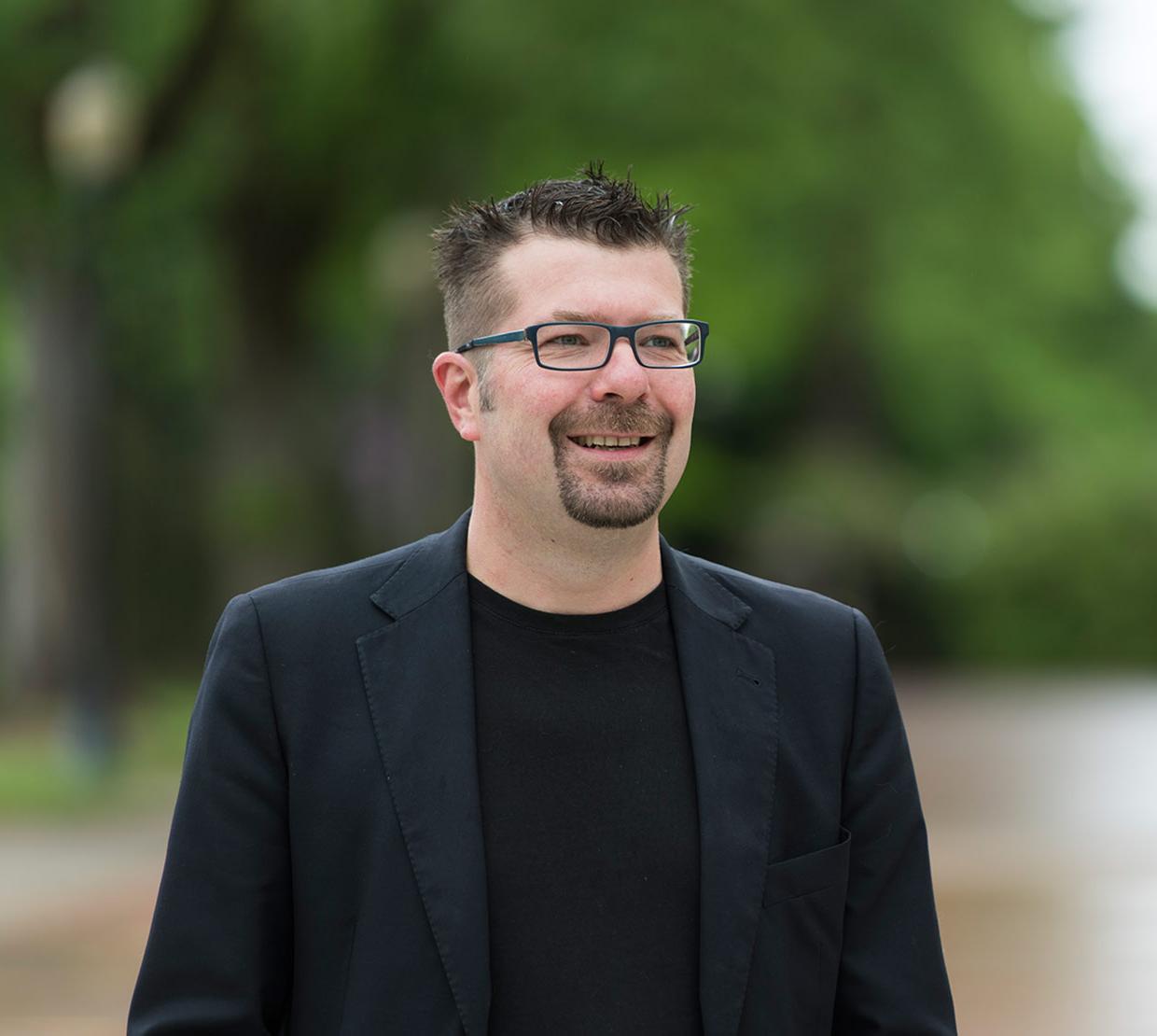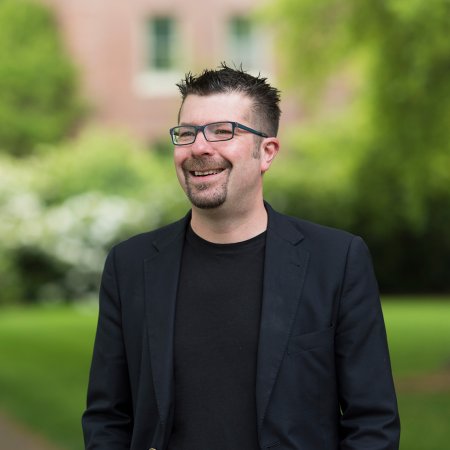The College of Science welcomes Xavier Siemens as a professor of physics beginning May 28, 2019. A renowned astrophysicist, Dr. Siemens joins us from the University of Wisconsin- Milwaukee (UWM) where he has held the rank of associate professor since 2011.
Siemens and his team search the universe for “super-massive black holes,” the largest type of black holes which are millions to billions of times the mass of the Sun. Last month, astronomers used a network of telescopes around the world to take the first-ever picture of a supermassive black hole. It was in the galaxy M87 more than 50 million light years away. The discovery opens up a new era in astrophysics.
“I am very excited that Dr. Siemens is joining our Department of Physics. He is a leading expert in gravitational-wave astronomy, the first fundamentally new type of astronomy since Galileo’s use of the telescope,” said Roy Haggerty, dean of the College of Science. “Dr. Siemens is a leader in his field and is pushing the envelope of discovery that will eventually allow us to observe the most violent collisions in the history of the universe – the mergers of galaxies.”
Gravitational wave astronomy brought the first direct observations of collisions of black holes in 2016 – an observation that Science magazine deemed the discovery of the year. In 2017, the new field brought us observations of two neutron stars colliding – which Science magazine again proclaimed it the discovery of the year.
“I am thrilled that our College has attracted an outstanding scientist like Xavier and that we were able to make this type of opportunity hire,” added Haggerty. “It is a testament to the strength of our research and our faculty as well as OSU’s hallmark spirit of collaboration.”
It is a good time for Siemens, who is originally from Madrid, Spain, but calls the U.S. home, to arrive at OSU: he will strengthen graduate and undergraduate offerings in astrophysics. Another benefit for Siemens is that he is joining his wife, Emmy Woessner, who has worked as a Psychologist at OSU’s Counseling and Psychological Services (CAPS) since 2012, and is making Corvallis home.
“Dr. Siemens is a leader in his field and is pushing the envelope of discovery that will eventually allow us to observe the most violent collisions in the history of the universe – the mergers of galaxies.”
A leading expert in gravitational-wave astronomy, Siemens has been a member of the LIGO Scientific Collaboration (LSC) since 2002 and participated in its Burst Search Group, as well as the Neutron Star Search Group and its Publications and Presentations Committee. He also served as co-chair of the LIGO Scientific Collaboration’s Calibration Team for about a decade. LIGO stands for Laser Interferometer Gravitational-Wave Observatory, a project created to detect gravitational waves from the cores of exploding stars, from colliding black holes and from rapidly rotating neutron stars in our Galaxy.
Siemens is also is part of the Leonard E. Park Center for Gravitation and Cosmology and Astrophysics (CGCA) at UWM. The group, which includes around 50 researchers, searches for gravitational waves from gamma-ray bursts, neutron-star and black-hole collisions, cosmic strings and rapidly spinning neutron stars. Most recently, their work was instrumental in the LIGO discovery of gravitational waves from colliding black holes in 2015, which was awarded the 2017 Nobel Prize in Physics. Their work also led to the subsequent discovery of multi-messenger emission from colliding neutron stars.
Siemens will spend much of his first year focused on a large-scale research center proposal to foster major advances at the intellectual frontiers of physics and to enable transformational advances in the most promising areas of physics research.
“Big Science needs this kind of wide-ranging expertise and broad thinking to solve the world’s pressing problems,” said Siemens, who spends much of his time applying management and leadership skills to run large-scale projects and to conduct strategic planning. He cites securing funding and generating consensus as among his most useful skills as a scientist in addition to his extensive technical knowledge.
At UWM, Siemens currently directs a National Science Foundation Physics Frontiers Center (PFC), the North American Nanohertz Observatory for Gravitational Waves, or NANOGrav. The center was founded in 2015 to expand and coordinate the North American low-frequency GW detection effort. Since then, NANOGrav has grown to almost 200 scientists and students in the U.S. and Canada and includes a mix of R1 institutions, liberal arts colleges and national labs. The center is supported by a $14.5M, five-year grant plus a $2.75M one-year supplement through 2021. It contributes to three of NSF’s 10 Big Ideas: Multi-messenger astrophysics, Harnessing the data revolution and NSF INCLUDES.
Siemens hopes to establish a similar center at OSU. To get started, he will begin recruiting graduate students and postdocs immediately.
“Big Science needs this kind of wide-ranging expertise and broad thinking to solve the world’s pressing problems,”
“Students will operate the world’s most sensitive radio telescopes in the world,” said Siemens. That is certain to attract students to the new astrophysics program. At OSU Siemens will significantly expand Physics’ Ecampus presence by teaching numerous online courses, including a new introductory course called “Descriptive Astronomy: Stars and the Universe.”
At UWM, Siemens taught a range of physics and astronomy courses, from Introductory Astronomy, Introductory Physics Without Calculus, Modern Physics and Classical Mechanics to graduate-level Cosmology and Quantum Field Theory. He also leads the Student Teams of Astrophysics Researchers (STARS@UWM), a program is specifically designed to enable undergraduate students to significantly contribute to cutting-edge research, including the detection and study of low-frequency gravitational waves via pulsar timing. In the past nine years, he has mentored or co-mentored about 100 undergraduate students in the program who were doing research, collaborating directly with their peers, graduate students and professional scientists internationally.
Siemens received a 2010 NSF CAREER award for his project, “Gravitational wave astronomy and a new generation of gravitational wave astronomers.” To date, he has received more than $29.34 million in funding from NSF and has authored over 250 publications.
Siemens received his undergraduate degree and his MSc in physics from Imperial College in London in 1995 and his Ph.D. from Tufts University in 2002. After completing his Ph.D., he worked as a Postdoctoral Research Associate at the University of Wisconsin-Milwaukee and then as a Senior Postdoctoral Scholar at the California Institute of Technology.




